
Centre for Applied Nanomedicine (CAN)
The Centre for Applied Nanomedicine (CAN) at the Research Institute of the McGill University Health Centre (RI-MUHC) is a specialized technology platform and research hub for studies on extracellular vesicles (EVs) and nanosized extracellular particles (EP). These nanosized bodies, present in all bodily fluids, are implicated in cellular communication and have been found to hold diagnostic and therapeutic potential.
The CAN supports researchers aiming to decipher the biology of EVs and EPs, and their involvement in various physiological and pathological conditions. Supported by the Canada Foundation for Innovation (CFI), CAN houses a range of state-of-the-art instrumentation that includes particle counters, particle sizers and equipment enabling multidimensional single-vesicle analysis.
- Mission
- Leadership and oversight
- Equipment listing
- Collaborating platforms and resources
- Contact us: Access to equipment and services
Mission
The Centre for Applied Nanomedicine (CAN) aims to build an environment that would support a community of researchers aiming to collaborate, exchange expertise, share and maintain state-of-the-art equipment in order to advance extracellular vesicle and nanomedicine science across a broad spectrum of basic and translational biomedical research areas.
Leadership and oversight
Learn more about CAN steering and advisory committees
Equipment listing
Located at the Glen site of the McGill University Health Centre, the Centre for Applied Nanomedicine is co-managed by the Immunophenotyping Platform and hosts the following equipment:

NanoSight NS300
- Sizing (10 to 1,000 nm)*
- Concentration (106 to 109 particles/mL)*
The NanoSight NS300 uses the technology of Nanoparticle Tracking Analysis (NTA), which utilizes the properties of both light scattering and Brownian motion in order to obtain the size distribution and concentration measurement of particles in aqueous buffers. The software analyses video files of individual particles and, using the Stokes-Einstein equation, calculates their hydrodynamic diameters.
*The instrument’s detection range of size and concentration may change depending on the nature of sample analysed
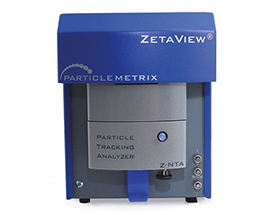
ZetaView PMX120
- Sizing (20 to 1,000 nm)*
- Zeta potential (± 200 mV; 500 nm upper limit of detection in zeta potential mode)
- Concentration (106 to 1010 particles/mL)*
- Fluorescence (excitation: 488 / emission: 530)
The ZetaView is a Nanoparticle Tracking Analysis (NTA) instrument for measuring hydrodynamic particle size, zeta potential and concentration in aqueous buffers. Each individual particle in the field of view is counted and tracked in short video clips, creating accurate concentration calculations and particle size distributions. The additional fluorescent mode (excitation 488/ emission 530) allows the analysis of the fluorescently labeled particles.
*The instrument’s detection range of size and concentration may change depending on the nature of sample analysed

nCS1
- Sizing (50 to 10,000 nm)*
- Concentration (104 to 1012 particles/mL)*
- Disposable microfluidic cartridges for different ranges of sizes
The nCS1 instrument relies on the principle of microfluidic resistive pulse sensing (MRPS) to accurately detect, measure and count particles across a broad range of sizes. The electrical sensing is used to measure the diameter of each particle as it passes through a nanoconstriction, providing real-time sizing and concentration information of EV and particle in solution. Usage of single-use disposable cartridges eliminates contamination between samples and reduces cleaning requirements.
*The instrument’s detection range of size and concentration may change depending on the nature of sample analysed
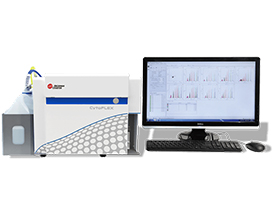
CytoFLEX
- Phenotypic characterisation of fluorescently labeled particles
- Relative sizing
- Colocalization
The CytoFLEX is a flow cytometer optimized for multiparameter analysis of nanoparticles, including exosome-sized EVs. This instrument is equipped with 3 lasers, blue (488), red (640) and violet (405) and 11 avalanche photodiode detectors (APD) to allow for efficient analysis of multiple fluorophore combinations at the level of individual particles. In addition to the traditional blue-SSC, this cytometer is outfitted with a violet-SSC that provides a better definition of small particles with a lower refractive index, such as exosomes, microvesicles and silica nanoparticles.
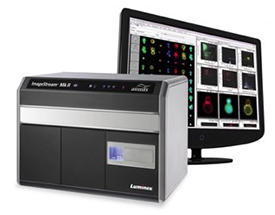
ImageStreamX Mk II
- Phenotypic characterisation of fluorescently labeled particles
- Particles-cell interaction
- Relative Sizing
- Colocalization
The ImageStreamX Mk II Imaging Flow Cytometer combines the speed, sensitivity, and phenotyping abilities of flow cytometry with the detailed imagery and functional insights of microscopy. This instrument is equipped with 3 lasers, blue (488), red (642) and violet (405), linked to 12 high-resolution imaging channels. The 20X, 40X and 60X lens system allows detection and phenotypical analysis of cells and small particles, including individual EVs.
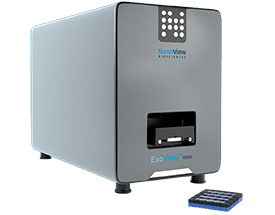
ExoView R200
- Fluorescent labeling of EVs (surface and intraluminal) on ready-to-use or customized chips
- Colocalization
- Sizing (50-200 nm)
The ExoView R200 allows for simultaneous biomarker colocalization analysis on immobilized particles coupled with size measurement. The multiplexed array allows multiple markers to be probed in parallel on ExoView chips. Fluorescent detection of 1-3 markers follows an antigen specific particle immobilisation on a ready-to-use or customized chip. The heterogeneity and complexity of particles and their populations can be examined through the compilation of the combined signals.
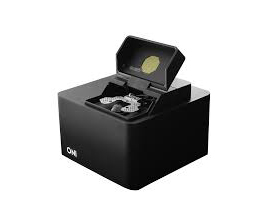
Nanoimager – ONI
- Fluorescent imaging of nanoparticles
- Multiple super resolution microscopy modalities
ONI is a complete package in super-resolution microscopy. It is equipped with cutting-edge imaging technologies, such as 2D and 3D Single-Molecule Localization Microscopy (SMLM), 3D Single-Particle Tracking (SPT), Total Internal Reflection Fluorescence (TIRF) and Förster Resonance Energy Transfer (FRET). The ONI system features illumination with 405nm, 488nm, 561nm, and 640nm lasers and allows to image a specimen (including nanoparticles) with high resolution reaching down to 20nm, thus facilitating better understanding of molecular interactions, intracellular dynamics and more through single-molecule fluorescence.
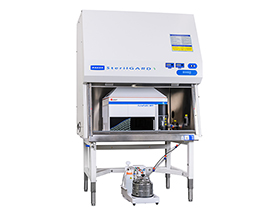
Beckman CytoFLEX SRT sorter
- Phenotypic characterisation and sorting of fluorescently labeled particles
The CytoFLEX SRT is an extracellular vesicle/nanoparticle dedicated fluorescence-activated sorter. The SRT has 4 lasers, blue (488), red (640), yellow-green (561) and violet (405), and 15 avalanche photodiode detectors (APD) to efficiently phenotype individual particles and ultimately allow efficient sorting. SRT sorter uses violet-SSC to detect small particles with lower refractive index. The instrument performs 1-way sort into plates and up to 4-way sort into tubes.
Extracellular vesicle prep room
This room, equipped with standard cell culture equipment, ultracentrifuge and bench space, allows for on-site preparation of samples as a part of the CAN workflow.
Collaborating platforms and resources
CAN is designed to be integrated into a network of technologies enabling upstream and downstream in-depth analysis of biological and engineered nanoparticles. Collaborating platforms and other resources may be accessed at the RI-MUHC and McGill University.
Collaborating platforms
- Super-resolution imaging, Molecular Imaging Platform at the RI-MUHC
- Lipidomics and analysis of metabolites at the Proteomics and Molecular Analysis Platform of the RI-MUHC and the Metabolomics Innovation Resource group of the Rosalind and Morris Goodman Cancer Institute
- Advanced mass spectrometry techniques Proteomics and Molecular Analysis Platform at the RI-MUHC
- Next generation nanotechnology at the McGill Biological and Biomedical Engineering Program
- Flow cytometry services, Immunophenotyping Platform at the RI-MUHC
- High throughput technologies for genomic studies at the McGill Genome Centre
Resources
The following resources provide more information on EV research, particularly the guidelines, central databases and consortia available online.
Guidelines:
- Minimal information for studies of extracellular vesicles 2018 (MISEV2018): a position statement of the International Society for Extracellular Vesicles and update of the MISEV2014 guidelines. (Watch for the release of MISEV 2022/2023!)
- MIFlowCyt-EV: A framework for standardized reporting of extracellular vesicle flow cytometry experiments
Central databases and consortia:
- International Society for Extracellular Vesicles
- EV-TRACK platform
- Vesiclepedia (data capture initiative)
- Exocarta (exosome protein, RNA and lipid database)
- Extracellular RNA Communication Consortium ExRNA research portal
Contact us: Access to equipment and services
For general consultation (workflow, sample isolation, etc.), NanoSight NS300, ZetaView, nCS1 and ExoView
CAN project managers
- Nadim Tawil, PhD, nadimPraesent id dolor porta, faucibus eros vel.tawil@mail.mcgill.ca
- Laura Montermini, M.Sc., lauraPraesent id dolor porta, faucibus eros vel.montermini@muhc.mcgill.ca
Please copy our managers on all communications pertaining to CAN.
For Cytoflex, ImageStream, and sorting
- Marie-Hélène Lacombe, M.Sc., immunophenotypingPraesent id dolor porta, faucibus eros vel.rimuhc@mcgill.ca
- Ekaterina Iourtchenko, M.Sc., ekaterinaPraesent id dolor porta, faucibus eros vel.iourtchenko@muhc.mcgill.ca
- Hélène Pagé-Veillette, M.Sc., helenePraesent id dolor porta, faucibus eros vel.page-veillette@muhc.mcgill.ca
For ONI nanoimager
- Min Fu, PhD, molecularimagingPraesent id dolor porta, faucibus eros vel.rimuhc@mcgill.ca
- Shi Bo Feng, M.Sc., shiPraesent id dolor porta, faucibus eros vel.feng@mail.mcgill.ca